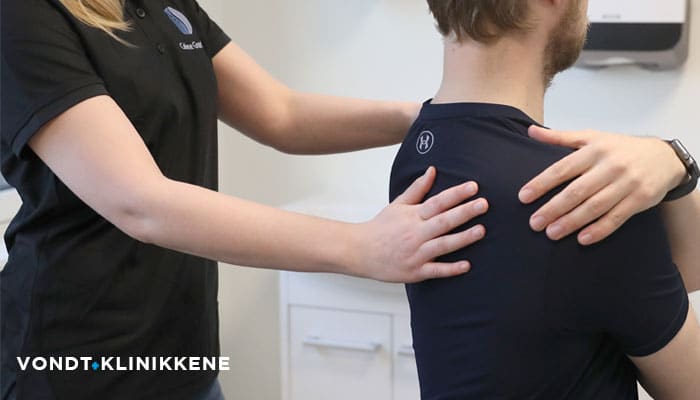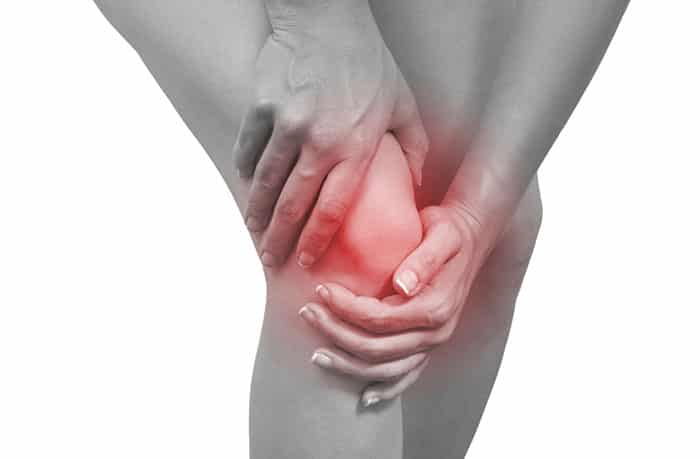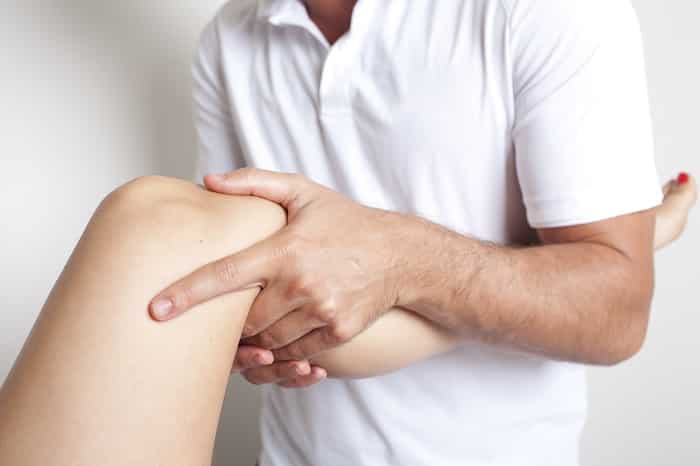
Anterior cruciate ligament (ACL) rupture / tearing / injury
An anterior cruciate ligament rupture / tearing / injury can make the knee unstable and painful. A tear of the anterior cruciate ligament can go far beyond your stability. Namely, anterior cruciate ligament acts as an internal stabilizer in the knee and the ligament's main purpose is to prevent the knee from hyperextending (going too far back). Anterior cruciate ligament injury is often called ACL injury after the English anterior cruciate ligament. A cruciate ligament may be partially or completely torn off by tearing (partial or full rupture). Feel free to contact us via Our Facebook page or comment box if you have any questions.
The Pain Clinics: Our Interdisciplinary and Modern Clinics
Our clinic departments at Vondtklinikkene (click here for a complete overview of our clinics) has a distinctively high level of professional expertise in the investigation, treatment and rehabilitation of knee diagnoses. Contact us if you want the help of therapists with expertise in knee pain.
How is anterior cruciate ligament damaged?
The injury mechanism of the anterior cruciate ligament is thus that the knee enters - and exceeds - its anatomical extension movement. This means that we either get a partial or complete rupture (tear) of this important knee ligament.
Anterior cruciate ligament injury can occur in both contact and non-contact sports. Some common sports where this injury often occurs are in football and alpine skiing. In football, there is a high chance that you get a tackle on the 'stand leg' and that the knee thus enters an unfavorable and violent movement (hyperextension). In alpine skiing, it is the forces and load from the icy surface that can gradually lead to an overload and consistent tearing in the anterior cruciate ligament.
Weak seat muscles (gluteal muscles) are also considered to be a major contributing cause of this diagnosis and knee problems in general.
Relief and load management in case of injuries to the cruciate ligament in the knee
Damage to the cruciate ligament in the knee leads to increased instability. Precisely for this reason, it is important to give the knee better stability and support - at the same time as contributing to injury healing. One knee compression support is ideal for this purpose, as it both contributes to more stability and stimulates circulation towards the injured area. Increased circulation can help to both reduce fluid accumulation and provide faster healing in the injured ligament.
Tips: Knee compression support (The link opens in a new window)
Click on the image or link to read more about the knee compression support and how it can help your knee.
Where is anterior cruciate ligament (ACL) anatomically speaking?
We find the anterior cruciate ligament deep inside the knee (see illustration at the top of the article and on the MRI image below) where it goes from the back of the knee and towards the middle attachment - due to its anatomical position it is one of the most important stabilizers the knee has.
What is O'Donaghue's Triad?
In contact sports (eg football & rugby) anterior cruciate ligament injury can often occur in combination with damage to the medial collateral ligament and medial meniscus. This is due to the injury mechanism that can occur in such trauma. When these three occur together, this triad of injuries is called the O'Donaghue Triad.
Who is affected by anterior cruciate ligament injury / tearing?
Athletes are usually affected. As mentioned, both in contact sports and non-contact sports. Women - among other things due to less hip strength / stability and other anatomical variations (wider pelvis and thus larger Q-angle that angles the knees more) - are affected three times as often as men.
Is anterior cruciate ligament tearing / injury dangerous?
In purely anatomical terms, it can lead to further degeneration of the knee and cause it to be previously affected by wear and osteoarthritis. It will also, over time, lead to meniscus damage if you do not do something about it. So no, it is not life threatening, but it is not harmless either and can lead to lasting men in the knee if you do not take the injury seriously. The earlier you receive assistance with training and rehabilitation from authorized health professionals, the better. It may also be appropriate to treat the knee for pain, as well as dysfunction of nearby muscles and joints.
Symptoms of anterior cruciate ligament tearing / rupture
A clear 'popping sound' in the event of twisting or sudden deceleration - followed by inability to continue the activity / sport and swelling / fluid accumulation, indicates a 90% chance that the anterior cruciate ligament has been torn off.
Causes of anterior cruciate ligament tearing / rupture
As mentioned earlier, injuries usually occur to the anterior cruciate ligament when a person stops abruptly and puts the majority of the weight through that leg. Cross-band injury can also occur when a person lands in an unnatural position (eg twisted knee and stretched leg).
Treatment of anterior cruciate ligament injury / tearing / rupture
In most cases the treatment of full rupture of the anterior cruciate ligament will take place in 3 stages:
1. Pre-operative training
Studies have shown that pre-operative training (pre-surgery training) is very important to ensure the best possible results and effect of the operation. Many people forget this important part of the rehabilitation phase and thus lose a lot of stability muscle which would help them to a faster functional progress when it comes to training and rehabilitation training after the surgery itself.
2. Surgery / pericardial surgery
In the case of total tearing of the anterior cruciate ligament, a 'graft' is normally used - from, for example, your own hamstring muscle - which is then operated on as a replacement for the anterior cruciate ligament. In recent times, peephole surgery has been used, which means that the entrance area itself is minimized and in this way the damaging tissue and scar tissue that can occur in the area after the surgical procedure is reduced - because scar tissue itself can be a big problem if it is too much of it.
3. Post-operative rehabilitation (post-operative training)
Training after surgery is a chapter for itself. Here one must start very slowly with isometric training before gradually increasing the training load and changing the training according to the number of weeks since the operation, as well as improvement. The training will often consist of balance exercises and specific strength exercises aimed at important and relevant muscles.
We strongly recommend that you be followed up by clinicians such as physiotherapist or chiropractor, and that you have follow-up hours and sub goals that are specifically worked on. This can provide both better training motivation and results.
Conservative treatment of anterior cruciate ligament injury
Muscle work / needle treatment can be used against nearby tight muscles. Low-dose laser therapy can also be used to stimulate increased repair. We recommend that you use an authorized health professional for such treatment.
Image diagnostics of anterior cruciate ligament tearing / rupture / injury
MRI examination is the gold standard (best image examination) for evaluating a cruciate ligament injury. This is because an MRI image can see both soft tissue and bone - which allows us to assess the health of the meniscus and cruciate ligament.
Anterior cruciate ligament prevention / rupture / injury
The best treatment is always prevention. When it comes to preventing and preventing anterior cruciate ligament injury, it is a question of strain versus your capacity in the knee and knee structures. If the load exceeds your capacity then damage will occur. Therefore, prevention is about increasing and improving factors that reduce the chance of injury.
Some of these factors include strength in the knee's muscle stabilizers, muscle fiber's speed / responsiveness (how quickly the muscles can respond to sudden stresses), coordination and balance.
A summary of the types of exercise that can strengthen the relevant muscles:
Balance training and coordination training: This form of exercise improves knee response time on load. It can also help ensure that you do not end up in vulnerable anatomical positions due to falls or the like. Here, both the balance board and the balance pad may be relevant.
Foot exercises: Exercise to strengthen the sole of the foot and arch can prevent injury by acting as the first shock absorber before the load hits the knee. More functional foot muscles can also ensure more correct use of the foot when walking and running - which also reduces incorrect loading.
Hip Training: Improved strength and function of the hip muscles can work shock absorbing for the knees.
Also read: - 10 Exercises That Give Stronger Hips
Good advice for acute knee injuries and suspected tendon or ligament damage
Seek out a clinician - it is important to diagnose the injury so that you know what is the best treatment and training further. Different diagnoses usually require different treatment plans. Even if you think that "this is over", it is simply stupid not to go to a clinician (chiropractor, physiotherapist, doctor or manual therapist) to be diagnosed with the problem - as a first examination usually does not cost more than 500-700 NOK and does not take longer than 45-60 minutes. It's a bit like ignoring the 'strange sound' in the car for a long time - it can lead to unforeseen problems later in the year.
Rest: If it is painful to put weight on the leg, you should see a clinician to diagnose the symptoms and pain - and not least avoid doing so. Instead, use the RICE principle and focus on relieving the area with associated icing and compression (feel free to use a support sock or bandage). Total absence of movement, however, is not recommended.
Icing / cryotherapy: In the first 72 hours after the injury, icing (also called cryotherapy) is important. This is because there will be fluid accumulation and swelling after an injury - and this is normally very excessive on the part of the body. To calm this response, it is therefore important to cool the area immediately after the damage has occurred and then 4-5x cycles during the day. Then a so-called icing protocol is used, which means that you do not ice directly on the skin (to avoid frostbite injuries) and that you ice down in cycles of «15 minutes on, 20 minutes off, 15 minutes on».
Pain medication: After consulting a doctor or pharmacist, keep in mind that NSAIDS (including Ibux / ibuprofen) can lead to a significantly slower healing time.
Do you need good advice, remedies and tips for anterior cruciate ligament damage?
Feel free to contact us directly through the comments section below or via social media (e.g. vår Facebook-side). We will help you as best we can. Write as fully as you can about your complaint so that we have as much information as possible to make a decision.
NEXT PAGE: - Sore knee? You should know this!
Also read: - The Worst Exercises If You Have Prolapse
Also read: - 6 Effective Strength Exercises for Sore Knee
What can I do even against pain in muscles, nerves and joints?
1. General exercise, specific exercise, stretching and activity are recommended, but stay within the pain limit. Two walks a day of 20-40 minutes make good for the whole body and sore muscles.
2. Trigger point / massage balls we strongly recommend - they come in different sizes so you can hit well even on all parts of the body. There is no better self help than this! We recommend the following (click the image below) - which is a complete set of 5 trigger point / massage balls in different sizes:
3. Training: Specific training with training tricks of various opponents (such as this complete set of 6 knits of different resistance) can help you train strength and function. Knit training often involves more specific training, which in turn can lead to more effective injury prevention and pain reduction.
4. Pain Relief - Cooling: Biofreeze is a natural product that can relieve pain by cooling the area gently. Cooling is especially recommended when the pain is very severe. When they have calmed down then heat treatment is recommended - it is therefore advisable to have both cooling and heating available.
5. Pain Relief - Heating: Warming up tight muscles can increase blood circulation and reduce pain. We recommend the following reusable hot / cold gasket (click here to read more about it) - which can be used both for cooling (can be frozen) and for heating (can be heated in the microwave).
6. Prevention and healing: Compression noise like that like this can increase blood circulation to the affected area, thereby speeding up the natural healing of injured or worn muscles and tendons.
Recommended products for pain relief in pain
Biofreeze (Cold / cryotherapy)
Sources:
-
Anterior cruciate ligament injury / tear / rupture | anterior cruciate ligament injury | pain in the knee on the front after trauma:
-
 Follow Vondt.net on YOUTUBE
Follow Vondt.net on YOUTUBE
(Follow and comment if you want us to make a video with specific exercises or elaborations for exactly YOUR issues)
 Follow Vondt.net on FACEBOOK
Follow Vondt.net on FACEBOOK
(We try to respond to all messages and questions within 24-48 hours. We can also help you interpret MRI responses and the like.)
















Leave a reply
Want to join the discussion?Feel free to Contribute!